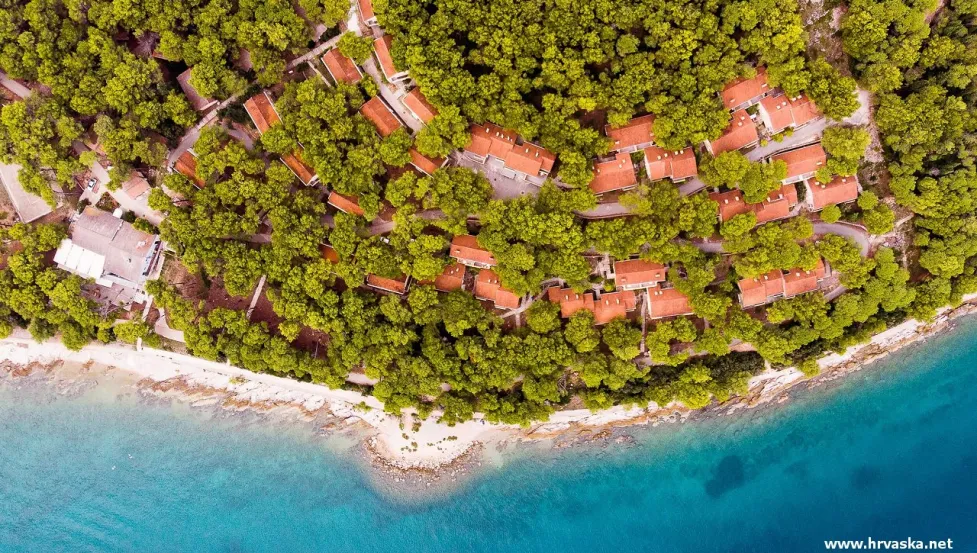Otok Lošinj
Island Losinj, Mali Losinj, Veli Losinj, mild climate, evergreen vegetation, is ideal for treatment of chronic respiratory diseases, Hotels Losinj, Hotel Aurora, Hotel Vespera, Apartments Losinj, Vila Losinj, Mobile home Losinj, Kvarner, Croatia
Geographical characteristics of the Cres-losinj archipelago
99 km long Kvarner islands Cres and Losinj extend from north-west toward south-east with total area covering 513 km2 or 16 % of the entire surface of Jadran archipelago. In the ancient history Cres and Losinj were one island, until the Illyrians excavated canal next to Osor.
Losinj group of island consists of islands Losinj (74, 68 km2), Unije (16, 77 km), Ilovik (5, 88 km2), Susak (3, 76 km2), Vele Srakane (1, 17 km2) and number of uninhabited islands and reefs. Island Losinj is 11th largest island in Jadran, 33 km long, with width that varies between 4.70 km on the middle of the island and 0, 25 km near Mali Losinj. Total coast length of Island Losinj is 112.7 km with index of relative indebtedness of 3.7.
Structure of the island is consisted of chalk limestone and dolomites of variant compositions. In the relief of Losinj we can distinguish two types of relief – 10 km long calcareous massif Osorscica with highest peaks Televrina (588 m) and St. Mikul (557 m) and slopes on its west side, and second type with characteristics of dinaric structures with several peaks over 200m - Kriška (217m) and St. Ivan (234m).
Island Losinj has mild climate, evergreen vegetation (myrrh, laurel, common oak, pine, cypress) and 2600 sunny hours per year. Average humidity amounts 70%, and average temperatures are 29 °C in summer and 7 °C in winter
History of the Cres and Losinj archipelago
Even the old Liburnians and Romans while sailing through the Osor Canal, excavated by Illyrians, recognized the benefits and beauty of these region. Romans inhabited Osor in 7th century, while the Croats at the same time settled on the rest of the Cres region. Smaller island Osor overgrown by bushes and woods, rangy and hardly passable, Osor's richmans used for cattle pasture.
Because of the poor living conditions they renamed it from Osor to Losinj. (Los in Croatian means bad). The first major settlement on the island of Losinj has been created in early 13th century, when according to legend,12 families under the leadership of Obrad Harnovic settled on Mount St. Nicholas (now Mount St.Ana in Veli Losinj).
Second, the small settlement, today's Mali Losinj, has been created at the end of 13th century when a group of immigrants settled in a bay of Saint Martin.
During the course of the history islands were governed by Republic of Venice, Byzantium, Austro Hungarian Monarchy.In 1920 by the end of the First World War, islands were assigned to the management of Italian fascists, until its capitulation in 1945. when they returned to the Croatian government.
19th century brings change, a stable political situation, the status of Losinj as a strong maritime center, and Cres as developed agricultural area. 1852 The captain Antonio Baricevic started the construction of shipyards in Veli Losinj. 1856 in order to expand the port Rovenska he builded breakwater, for which the foundation stone was laid by the Hapsburg Archduke Maximilian, the younger brother of Emperor Franz Joseph I.
In 1868 Mali Losinj reached its peak, and with 11 shipyards became a place with the strongest commercial fleet in the Adriatic. Developmental stagnation of Losinj started after steam engine invention and with appearance of peronospora - diseases of the vine, a rapid displacement of population started, mostly to America.
Mild climate, rich flora and the exceptional quality of the air with high sea aerosol levels, 1892 provided Losinj with a status of winter health and climate resort. In 1893 Spiridon Gopcevic opened first astronomical observatory in Adriatic and launched first astronomy journal.
Climate of island Losinj
Due to its favorable position and warm sea current of the south Mediterranean circulating around its shores, Losinj has mild Mediterranean climate which are characterized by hot and dry summers and mild and rainy winters. Rainy months are September, November and December while the rest of the season is dry. If we take into consideration abundance of plant species, positive impact of the sea aerosol, average air humidity of 70%, little variations between average minimum and maximum air temperatures and annual insulation of 2563 hours per year, Losinj climate is ideal for treatment of chronic respiratory diseases. Thanks to prof. Ambroz Haračić who opened first weather station in Mali Losinj on august 01st 1880. and linked it with meteorological Institute in Vienna, worldly attention was directed towards beneficial climate of island Losinj. Ministry of Health the Austro-Hungarian monarchy proclaimed Losinj as a climate and health resort in 1892.
Thanks to this researches Hapsburg Archduke Charles Stephen built castle in Podjavori region in 1886. along with cultivated garden filled with various exotic plants..
Due to professor Haracic, large rocky areas of the island Losinj were reforested - dense pine forest became a symbol of the island today and are of immeasurable value.





